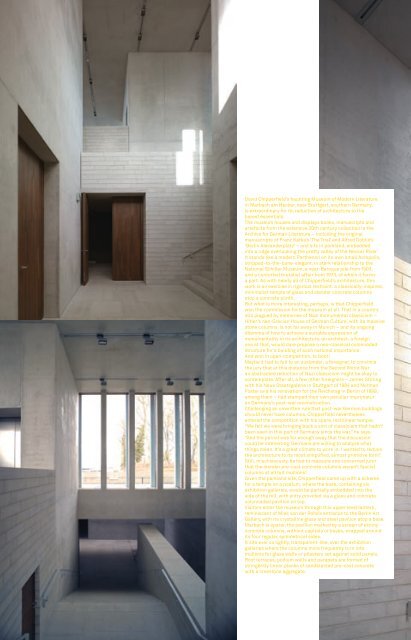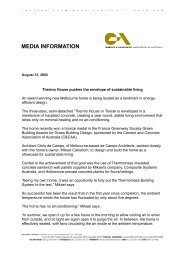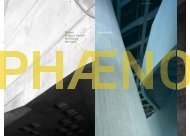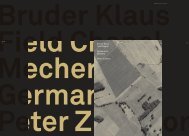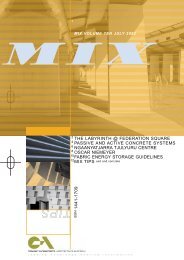Museum of Modern Literature Marbach, Germany David Chipperfield
Museum of Modern Literature Marbach, Germany David Chipperfield
Museum of Modern Literature Marbach, Germany David Chipperfield
Create successful ePaper yourself
Turn your PDF publications into a flip-book with our unique Google optimized e-Paper software.
<strong>David</strong> <strong>Chipperfield</strong>’s haunting <strong>Museum</strong> <strong>of</strong> <strong>Modern</strong> <strong>Literature</strong><br />
in <strong>Marbach</strong> am Neckar, near Stuttgart, southern <strong>Germany</strong>,<br />
is extraordinary for its reduction <strong>of</strong> architecture to the<br />
barest essentials.<br />
The museum houses and displays books, manuscripts and<br />
artefacts from the extensive 20th century collection in the<br />
Archive for German <strong>Literature</strong> – including the original<br />
manuscripts <strong>of</strong> Franz Kafka’s ‘The Trial’ and Alfred Doblin’s<br />
‘Berlin Alexanderplatz’ – and sits in parkland, embedded<br />
into a ridge overlooking the pretty valley <strong>of</strong> the Neckar River.<br />
It stands like a modern Parthenon on its own small Acropolis,<br />
stripped-to-the-bone-elegant, in stark relationship to the<br />
National Schiller <strong>Museum</strong>, a near-Baroque pile from 1903,<br />
and a contorted brutalist affair from 1973, <strong>of</strong> which it forms<br />
a part. As with nearly all <strong>of</strong> <strong>Chipperfield</strong>’s architecture, this<br />
work is an exercise in rigorous restraint: a classically-inspired,<br />
minimalist temple <strong>of</strong> glass and slender concrete columns<br />
atop a concrete plinth.<br />
But what is more interesting, perhaps, is that <strong>Chipperfield</strong><br />
won the commission for the museum at all. That in a country<br />
still plagued by memories <strong>of</strong> Nazi monumental classicism –<br />
Hitler’s neo-Grecian House <strong>of</strong> German Culture, with its massive<br />
stone columns, is not far away in Munich – and its ongoing<br />
dilemma <strong>of</strong> how to achieve a suitable expression <strong>of</strong><br />
monumentality in its architecture, an architect, a foreign<br />
one at that, would dare propose a neo-classical colonnaded<br />
structure for a building <strong>of</strong> such national importance.<br />
And won in open-competition, to boot!<br />
Maybe it had to fall to an auslander, a foreigner, to convince<br />
the jury that at this distance from the Second World War<br />
an abstracted reduction <strong>of</strong> Nazi classicism might be okay to<br />
contemplate. After all, a few other foreigners – James Stirling<br />
with his Neue Staatsgalerie in Stuttgart <strong>of</strong> 1984 and Norman<br />
Foster and his renovation for the Reichstag in Berlin <strong>of</strong> 1999,<br />
among them – had stamped their own peculiar imprimatur<br />
on <strong>Germany</strong>’s post-war reconstruction.<br />
Challenging an unwritten rule that post-war German buildings<br />
should never have columns, <strong>Chipperfield</strong> nevertheless<br />
entered the competition with his spare, rectilinear temple.<br />
“We felt we were bringing back a sort <strong>of</strong> classicism that hadn’t<br />
been seen in this part <strong>of</strong> <strong>Germany</strong> since the war,” he says.<br />
“And the period was far enough away that the discussion<br />
could be interesting. Germans are willing to analyze what<br />
things mean. It’s a great climate to work in. I wanted to reduce<br />
the architecture to its most simplified, almost primitive form”.<br />
Still, mischievously, he had to reassure one concerned juror<br />
that the slender pre-cast concrete columns weren’t fascist<br />
columns at all but mullions!<br />
Given the parkland site, <strong>Chipperfield</strong> came up with a scheme<br />
for a temple on a podium, where the base, containing six<br />
exhibition galleries, would be partially embedded into the<br />
side <strong>of</strong> the hill, with entry provided via a glass and concrete<br />
colonnaded pavilion on top.<br />
Visitors enter the museum through this upper level lantern,<br />
reminiscent <strong>of</strong> Mies van der Rohe’s entrance to the Berlin Art<br />
Gallery, with its crystalline glass and steel pavilion atop a base.<br />
<strong>Marbach</strong> is sparer, the pavilion marked by a screen <strong>of</strong> skinny<br />
concrete columns, without capitals or bases, wrapped around<br />
its four regular, symmetrical sides.<br />
It sits ever so lightly, transparent-like, over the exhibition<br />
galleries where the columns more frequently turn into<br />
mullions for glass walls or pilasters set against solid panels.<br />
Ro<strong>of</strong> terraces, podium walls and parapets are formed <strong>of</strong><br />
stringently linear planks <strong>of</strong> sandblasted pre-cast concrete<br />
with a limestone aggregate.


